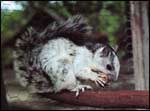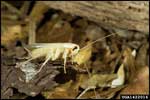Albinos
Survival for any length of time in the predatory world of wildlife is difficult enough under normal conditions, but it is almost impossible for the albino (al-BY-noh) animal. An albino is born without the ability to produce color pigment in its skin, hair, feathers, scales, or eyes. As a result, its hair, feathers, or scales range from snowy white to an off-white straw color. Any exposed skin usually has a pinkish look from the network of blood vessels visible through the transparent skin tissue. With the exception of its white coloration, the albino resembles normal members of its species in all respects. When it is natural for members of the species to be white, the true albino can be distinguished by its pink or red eyes. This distinctive eye color is caused by the blood in the tiny vessels of the iris showing through the transparent parts. (In a normal eye, the colored iris hides these blood vessels).
Absence of protective
coloration makes the albino’s
eyes extremely sensitive
to light. The unfortunate
creature, if not born blind,
must live with very poor
vision in a world that usually
requires highly developed
powers of sight for survival.
A bird of prey, which must
rely on keen eyesight to
locate its prey, is at a
definite disadvantage at
mealtime if it is an albino.
However, weak eyesight is
only one of the albino’s
problems.

Partial albinism occurs when an animal is unable to produce color pigments in some parts of its body. It may appear as white spots, blotches, or stripes, or it may involve a large portion of the animal's body. Usually the partial albino does not have the pink eyes of the true albino.
In most species, body coloration serves as camouflage, helping prey species hide from predators and allowing predators to approach their quarry without being seen. Naturally colored animals blend into their environment, but the albino finds itself in direct contrast most of the time. This creates quite a problem for the albino predator trying to sneak up on lunch, or the albino prey trying to hide from its enemies. As you would expect, the white predator often starves and the white prey quickly is found and eaten.
Sunshine adds more problems. The albino’s skin, which has no color pigment to protect it from the harmful effects of ultraviolet rays, sunburns easily. The usual daytime radiation from the sun also can cause additional damage to its already light-sensitive eyes.
Fortunately, true albinism occurs very rarely in the wild. Some say it happens only once in every hundred thousand births. Others claim it is even more rare—one in a million. Since the condition is so uncommon and there are so many strikes against an albino’s survival, spotting one in the wild is a rare experience indeed.
Probably because of their unique appearance, albinos have been given a special place in our literature and folklore. One of the most famous albinos of literature is Captain Ahab’s great white whale Moby Dick. Tales of the people of the far North include a white reindeer, and the American Indians had their legendary white buffalo. This animal supposedly held the power of the Great Spirit, and to look upon it gave the observer some of that awesome power. Buffalo hunters sought the albino buffalo for a more practical reason—the extra money its rare white hide would bring them.
Partial albinism occurs
when an animal is unable
to produce color pigments
in only some parts of
its body. This type of
albinism may appear as
white spots, blotches,
and stripes, or it may
involve a large portion
of the animal’s
body. Partial albinos
are relatively common
and usually do not have
the pink eyes of a complete
albino. Since they do
not have the extreme problems
of either, their survival
rate is much better.

Another color abnormality often confused with true albinism is known as xanthorism (ZAN-thor-ism). Xanthic (ZAN-thick) animals suffer from an absence of all color pigments except yellow. It is not uncommon to see golden-colored squirrels and raccoons. This yellow coloration also occurs frequently in reptiles and amphibians.
On the opposite end of the color spectrum from albinos are those animals with an overproduction of color pigment. This condition, known as melanism (MEL-uh-niz-um), gives the animal a black or much darker than normal appearance. Survival is improved for these melanistic animals. Their additional pigmentation protects them from sunlight exposure and increases their ability to absorb heat in cold weather. The darker coloration also makes it easier for those animals active at night to conceal themselves.
Albinism, xanthorism, and melanism are abnormal color conditions and should not be confused with color differences within a species caused by age, time of year, or a condition called dichromatism (di-KRO-muh-tiz-um), which means having two color phases independent of age or sex. Screech owls are a good example of dichromatism. They can be born with either reddish brown or gray coloration, and both color phases may appear in the same brood. For years the blue goose was thought to be a separate species from the snow goose, but biologists now know they are just different color phases of the same species.
Seasonal differences in color occur through shedding or molting. One of the more drastic seasonal changes is accomplished by the shorttail weasel when it trades its brown summer coat for a white winter coat and black-tipped tail. The fur on its winter coat is known as ermine. A less noticeable change is the deer’s reddish brown summer coat and its grayer winter one.
Birds are especially good examples of the difference age makes in body coloration. In many species the young are colored and patterned quite unlike the adults. The immature little blue heron is snowy white, but the adult is slaty blue with a dark maroon neck that appears blackish at a distance. Another example is the white immature roseate spoonbill that acquires its bright pink coloring as it matures to adulthood.
Normal animal coloration and its purpose in nature is an interesting subject to pursue. A book that will help you learn more about this is Animal Coloration by Ivan Heran.
Ilo
Hiller
1983 Albinos.
Young
Naturalist. The
Louise Lindsey Merrick
Texas Environment Series,
No. 6, pp. 28-31. Texas
A&M University Press,
College Station.